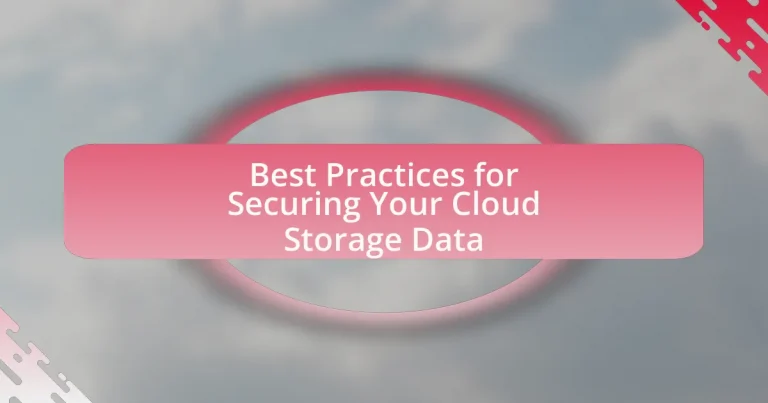The article focuses on best practices for securing cloud storage data, emphasizing the importance of implementing strong encryption, multi-factor authentication, and regular security audits. It outlines the risks associated with unsecured cloud storage, including data breaches and compliance violations, and discusses the significant impacts these breaches can have on individuals and organizations. Key principles of cloud data security, such as access control and data integrity, are highlighted, along with tools and technologies that enhance security. The article also addresses common challenges in cloud security and provides practical tips for individuals and organizations to improve their data protection strategies.
What are the Best Practices for Securing Your Cloud Storage Data?
The best practices for securing your cloud storage data include implementing strong encryption, using multi-factor authentication, regularly updating access permissions, and conducting routine security audits. Strong encryption protects data both at rest and in transit, making it unreadable to unauthorized users. Multi-factor authentication adds an additional layer of security by requiring multiple forms of verification before granting access. Regularly updating access permissions ensures that only authorized personnel have access to sensitive data, reducing the risk of insider threats. Routine security audits help identify vulnerabilities and ensure compliance with security policies. These practices are supported by industry standards, such as the National Institute of Standards and Technology (NIST) guidelines, which emphasize the importance of a layered security approach in cloud environments.
Why is securing cloud storage data important?
Securing cloud storage data is important to protect sensitive information from unauthorized access and data breaches. With the increasing reliance on cloud services, the risk of cyberattacks has escalated, making it essential to implement robust security measures. According to a report by McAfee, 21% of organizations experienced a data breach in the cloud, highlighting the critical need for effective security protocols. Additionally, securing cloud data ensures compliance with regulations such as GDPR and HIPAA, which mandate the protection of personal and sensitive information.
What risks are associated with unsecured cloud storage?
Unsecured cloud storage poses significant risks, including data breaches, unauthorized access, and data loss. These vulnerabilities arise from inadequate security measures, such as weak passwords and lack of encryption, which can lead to sensitive information being exposed to cybercriminals. According to a 2020 report by the Cloud Security Alliance, 64% of organizations experienced a cloud security incident due to misconfigured cloud settings, highlighting the importance of proper security configurations. Additionally, unsecured cloud storage can result in compliance violations, as organizations may fail to meet regulatory requirements for data protection, leading to legal repercussions and financial penalties.
How can data breaches impact individuals and organizations?
Data breaches can severely impact individuals and organizations by compromising sensitive information, leading to financial loss and reputational damage. For individuals, the exposure of personal data can result in identity theft, fraud, and emotional distress, with studies indicating that victims of identity theft can spend an average of 40 hours resolving issues related to the crime. Organizations face significant consequences, including legal penalties, loss of customer trust, and operational disruptions; for instance, the average cost of a data breach for a company was estimated at $4.24 million in 2021, according to IBM’s Cost of a Data Breach Report. These impacts highlight the critical need for robust security measures to protect data in cloud storage.
What are the key principles of cloud data security?
The key principles of cloud data security include data encryption, access control, data integrity, and compliance with regulations. Data encryption protects sensitive information by converting it into a secure format that can only be read by authorized users. Access control ensures that only authenticated users can access specific data, minimizing the risk of unauthorized access. Data integrity involves maintaining the accuracy and consistency of data over its lifecycle, which is crucial for preventing data corruption or loss. Compliance with regulations, such as GDPR or HIPAA, ensures that organizations adhere to legal standards for data protection, thereby safeguarding user privacy and maintaining trust. These principles collectively form a robust framework for securing cloud data.
How does data encryption enhance security?
Data encryption enhances security by converting sensitive information into a coded format that is unreadable without the appropriate decryption key. This process protects data from unauthorized access, ensuring that even if data is intercepted during transmission or accessed from a compromised storage system, it remains secure and confidential. According to the National Institute of Standards and Technology (NIST), encryption is a critical component of data protection strategies, as it mitigates risks associated with data breaches and unauthorized disclosures.
What role do access controls play in protecting data?
Access controls are essential in protecting data by regulating who can view or use information within a system. They ensure that only authorized users have access to sensitive data, thereby reducing the risk of data breaches and unauthorized access. For instance, implementing role-based access control (RBAC) allows organizations to assign permissions based on user roles, which has been shown to significantly lower the likelihood of data exposure. According to a study by the Ponemon Institute, organizations with effective access controls experience 50% fewer data breaches compared to those without such measures.
What tools and technologies can help secure cloud storage data?
Encryption tools, such as AES (Advanced Encryption Standard) and RSA (Rivest-Shamir-Adleman), are essential for securing cloud storage data. These technologies protect data by converting it into a format that is unreadable without the appropriate decryption key, ensuring that even if unauthorized access occurs, the data remains secure. Additionally, multi-factor authentication (MFA) enhances security by requiring users to provide two or more verification factors to gain access, significantly reducing the risk of unauthorized access. Regular security audits and compliance tools, such as those provided by ISO 27001 and GDPR frameworks, help organizations assess and maintain their security posture, ensuring adherence to best practices. Together, these tools and technologies create a robust security framework for cloud storage data.
What are the benefits of using multi-factor authentication?
Multi-factor authentication (MFA) significantly enhances security by requiring users to provide multiple forms of verification before accessing accounts. This additional layer of security reduces the risk of unauthorized access, as even if a password is compromised, an attacker would still need the second factor, such as a text message code or biometric verification, to gain entry. According to a study by the Cybersecurity & Infrastructure Security Agency, MFA can block up to 99.9% of automated cyberattacks, demonstrating its effectiveness in protecting sensitive data stored in the cloud.
How can security monitoring tools detect threats?
Security monitoring tools detect threats by analyzing network traffic, system logs, and user behavior to identify anomalies that may indicate malicious activity. These tools utilize techniques such as signature-based detection, which compares incoming data against known threat signatures, and anomaly-based detection, which establishes a baseline of normal behavior to flag deviations. For instance, according to a report by the Ponemon Institute, organizations that implement security monitoring tools can reduce the average time to detect a breach by 50%, demonstrating their effectiveness in threat detection.
How can organizations implement a cloud security strategy?
Organizations can implement a cloud security strategy by establishing a comprehensive framework that includes risk assessment, data encryption, access controls, and continuous monitoring. First, conducting a risk assessment helps identify vulnerabilities and threats specific to the cloud environment. Next, employing data encryption ensures that sensitive information is protected both in transit and at rest, which is crucial given that 94% of organizations experience data breaches due to inadequate security measures. Implementing strict access controls, such as multi-factor authentication and role-based access, further mitigates risks by ensuring that only authorized personnel can access sensitive data. Finally, continuous monitoring and regular audits of cloud services enable organizations to detect and respond to security incidents promptly, thereby maintaining a robust security posture.
What are the common challenges in securing cloud storage data?
Common challenges in securing cloud storage data include data breaches, insufficient access controls, and compliance issues. Data breaches can occur due to vulnerabilities in cloud infrastructure or human error, leading to unauthorized access to sensitive information. Insufficient access controls often result from poorly configured permissions, allowing unauthorized users to access data. Compliance issues arise when organizations fail to adhere to regulations such as GDPR or HIPAA, which can lead to legal penalties and loss of customer trust. According to a 2021 report by the Cloud Security Alliance, 64% of organizations cited data breaches as a significant concern in cloud security, highlighting the critical need for robust security measures.
How can organizations overcome these challenges?
Organizations can overcome challenges in securing cloud storage data by implementing robust security measures such as encryption, access controls, and regular audits. For instance, employing end-to-end encryption ensures that data is protected both at rest and in transit, making it inaccessible to unauthorized users. Additionally, establishing strict access controls, including multi-factor authentication, limits data access to only those who need it, thereby reducing the risk of breaches. Regular security audits help identify vulnerabilities and ensure compliance with industry standards, further strengthening the organization’s security posture.
What are the best practices for individuals using cloud storage?
The best practices for individuals using cloud storage include using strong, unique passwords, enabling two-factor authentication, regularly updating software, and organizing data effectively. Strong passwords reduce the risk of unauthorized access, while two-factor authentication adds an extra layer of security by requiring a second form of verification. Regular software updates ensure that security vulnerabilities are patched, protecting data from potential threats. Additionally, organizing data helps in managing files efficiently and facilitates easier retrieval, which can minimize the risk of accidental deletion or loss. These practices collectively enhance the security and usability of cloud storage solutions.
How can users create strong passwords for cloud accounts?
Users can create strong passwords for cloud accounts by combining a mix of uppercase letters, lowercase letters, numbers, and special characters, ensuring the password is at least 12 characters long. This complexity makes it significantly harder for attackers to guess or crack the password. Research indicates that passwords with a length of 12 characters or more can withstand brute-force attacks for a longer duration, as the number of possible combinations increases exponentially with each additional character. Additionally, using unique passwords for different accounts prevents a single breach from compromising multiple services, further enhancing security.
What steps should users take to regularly back up their data?
Users should take the following steps to regularly back up their data: establish a backup schedule, choose reliable backup methods, and verify the integrity of backups. Establishing a backup schedule ensures that data is backed up consistently, whether daily, weekly, or monthly, depending on the frequency of changes. Choosing reliable backup methods, such as cloud storage, external hard drives, or automated backup software, provides multiple layers of protection against data loss. Verifying the integrity of backups involves checking that the backed-up data is complete and accessible, which can be done by performing regular test restores. These steps collectively help maintain data security and accessibility, reducing the risk of data loss.
What are the latest trends in cloud storage security?
The latest trends in cloud storage security include the adoption of zero-trust security models, enhanced encryption techniques, and the implementation of advanced threat detection systems. Zero-trust models operate on the principle of “never trust, always verify,” ensuring that every access request is authenticated and authorized, which significantly reduces the risk of data breaches. Enhanced encryption techniques, such as end-to-end encryption and homomorphic encryption, protect data both at rest and in transit, making it unreadable to unauthorized users. Advanced threat detection systems utilize machine learning and artificial intelligence to identify and respond to potential threats in real-time, improving the overall security posture of cloud storage solutions. These trends are supported by industry reports indicating that organizations implementing these strategies have seen a marked decrease in security incidents.
How is artificial intelligence being used in cloud security?
Artificial intelligence is being used in cloud security primarily for threat detection and response automation. AI algorithms analyze vast amounts of data to identify patterns indicative of security threats, such as unusual access attempts or data exfiltration activities. For instance, according to a report by McKinsey, organizations employing AI-driven security solutions can reduce the time to detect and respond to threats by up to 90%. This capability enhances the overall security posture of cloud environments by enabling proactive measures against potential breaches.
What emerging threats should users be aware of?
Users should be aware of emerging threats such as ransomware attacks, data breaches, and insider threats. Ransomware attacks have increased by 150% in recent years, targeting cloud storage systems to encrypt data and demand payment for decryption. Data breaches, often resulting from weak passwords or phishing attacks, expose sensitive information; in 2021 alone, over 22 billion records were compromised globally. Insider threats, which involve employees misusing access to data, have also risen, with a significant percentage of organizations reporting incidents. These threats highlight the need for robust security measures in cloud storage.
What practical tips can enhance cloud storage security?
To enhance cloud storage security, implement strong password policies and enable two-factor authentication. Strong passwords should be complex, combining letters, numbers, and symbols, while two-factor authentication adds an additional layer of security by requiring a second form of verification, such as a text message or authentication app. According to a 2021 report by Verizon, 81% of data breaches are linked to weak or stolen passwords, highlighting the importance of robust password management and multi-factor authentication in protecting sensitive data stored in the cloud.


